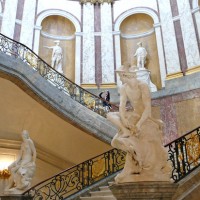-
Dealers' Heirs Seek Restitution of Bode Museum's Guelph Treasure
10/15/2013
 At the center of one of Germany’s largest restitution claims is the Berlin portion of the Guelph Treasure, a trove of ecclesiastical art, largely comprised of gem-encrusted reliquaries and crosses, dating from the 11th through 15th centuries. The hoard of precious objects was originally housed in the Braunschweig cathedral, and in 1671 it passed into the hands of the princely House of Guelph. In 1929 the Guelph family sold 82 items to a consortium of Frankfurt art dealers, and over the next few years, 40 pieces were sold to various museums and private collectors. In 1935, the Prussian state, with Hermann Goering’s backing, paid 4.25 million Reichsmarks for the remaining pieces. Today this portion of the Guelph Treasure, now valued at more than $200 million, is housed in Berlin’s Bode Museum.
At the center of one of Germany’s largest restitution claims is the Berlin portion of the Guelph Treasure, a trove of ecclesiastical art, largely comprised of gem-encrusted reliquaries and crosses, dating from the 11th through 15th centuries. The hoard of precious objects was originally housed in the Braunschweig cathedral, and in 1671 it passed into the hands of the princely House of Guelph. In 1929 the Guelph family sold 82 items to a consortium of Frankfurt art dealers, and over the next few years, 40 pieces were sold to various museums and private collectors. In 1935, the Prussian state, with Hermann Goering’s backing, paid 4.25 million Reichsmarks for the remaining pieces. Today this portion of the Guelph Treasure, now valued at more than $200 million, is housed in Berlin’s Bode Museum.
Now the heirs of four of the dealers—Zacharias Hackenbroch, Isaac Rosenbaum, Saemy Rosenberg and Julius Falk Goldschmidt, who were Jewish—are seeking restitution of the pieces, claiming that they were pressured into selling them by the Nazis in 1935. The dispute is complicated by a rival claim by the heirs of Frankfurt jewelry dealer, Hermann Netter, who say that he owned 25% of the Guelph Treasure. The case was to be discussed by a German government panel in September, but the hearing was adjourned so that new reports on the composition of the consortium could be further studied.
Forced sales were common during the Nazi era, as Jewish dealers and collectors were persecuted, victimized, and stripped of their possessions and livelihoods. The Prussian Cultural Heritage Foundation, which oversees Berlin’s art collections, is fighting the claims, stating that the sale of the Guelph Treasure was not due to Nazi duress. It maintains that the dealers got a fair price for the treasure (85% of the purchase price), and that the Prussian state was the only interested buyer. Attorneys for the heirs of the dealers say they were “coerced and forced by Goering to turn over the collection.” Indeed, under laws enacted by the Allies that are still in effect in Germany today, art sales by Jewish collectors and dealers in Germany after 1933 are presumed to have been made under duress.
While it can be difficult to prove that a sale was forced, the conditions impacting the lives and businesses of Jewish art dealers make any transaction from that time period dubious. It is up to the current owner to disprove the assumption that a sale was forced, and the outcome of restitution cases, including the Guelph Treasure, will hinge on this crucial question.
Art Law Blog
